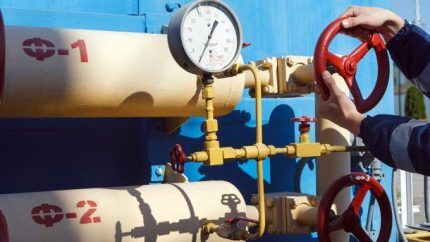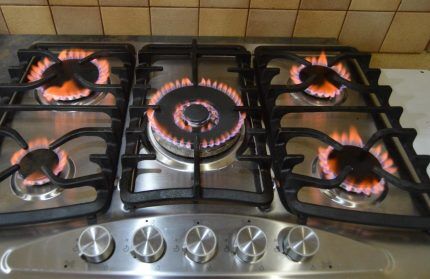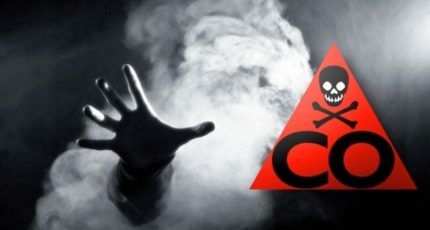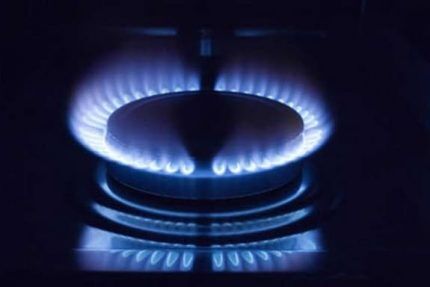Why gas burns with a red flame on the stove: factors affecting the color of the flame
Over time, many people notice how the color of the flame changes from blue to some other color.The question arises: what color should the gas be on the stove during normal operation of the equipment? Is it normal that it lights up not blue, but some other color? And in what cases does a change in flame color indicate serious problems.
Indeed, a change in flame color almost always indicates problems. But most of them can be solved independently and without even calling special services. Let's look at why gas sometimes burns with an orange rather than a blue flame, and how to fix this problem.
The content of the article:
Causes of flame color changes
Gas equipment is classified as unsafe household appliances. On the one hand, the user should not interfere with its operation and disturb the design of the stove, or try to repair it themselves.
On the other hand, it is important to know the possible signs of breakdowns and respond to them in time so as not to use a hob that has failed.

One of the simplest signs of problems with the stove is a change in the color of the fire. Normally it is blue, but sometimes it can turn orange, red, yellow, and have a pungent and unpleasant odor.
An important condition for normal gas combustion is the required amount of oxygen. There is a certain proportion that must be observed in order for combustion to be as beneficial as possible for the user.
Reasons for changing flame color:
- incomplete combustion of gas;
- incorrect amount of air in the mixture (insufficient or excessive);
- dirty burners;
- inappropriate equipment;
- low quality gas.
There is an opinion that a change in gas color indicates poor quality of the supplied fuel. Allegedly, it is diluted with various substances so that the consumer pays more for the service. In fact, the color of the fire only indicates how correctly the combustion process is carried out.
Thus, a uniform blue color indicates complete combustion of the gas, extracting the maximum amount of heat.

But the supply of low-quality gas cannot be ruled out. This does not affect the color of combustion itself, but poor-quality gas in the future worsens the performance of the stove and leads to the appearance of a yellow flame.
After the stove is in use, black soot may accumulate on it. All this indicates that the flame is smoking. This indicates a gas injection failure. When the burners are operating, there is a lack of gas mixture. This is why gas sometimes burns with a red or yellow flame on the stove.
It is necessary to look for the cause primarily in contamination of the burners, problems with ventilation, etc. The higher the combustion temperature, that is, the more saturated the gas is with oxygen during combustion, the colder the shade of the flame.
Yellow flame color
The air-fuel mixture becomes unusable and changes color for various reasons. The most common is that the holes intended for air intake become clogged. Dust gets into them, which prevents the free passage of air.
This problem is especially relevant in the first years of using gas equipment.This is when it needs to be tested most often. This is due to the fact that after stamping, a small oil film remains on the burner and the ignition group tube for the first time. This leads to dust sticking to its surface, which prevents the normal amount of air from entering. Gas flows in the same amount.
The composition of the mixture changes, and this becomes the reason why the gas burns orange or yellow in the stove, and not the traditional blue or blue.

It is important to understand that a change in flame color is not the only sign that it is time to clean the stove.
Other indicators are as follows:
- the flame smokes;
- the fire takes on an opaque hue;
- the torch becomes too large;
- the torch becomes glowing.
All this indicates the need to call a technician to clean the burners, their various elements and adjust the operation of the stove so that the air is supplied evenly.
Another common cause of a gas flame turning yellow is that the air control valve is not in the correct position. It may be closed, come off, fall, etc. This causes a lack of air, which leads to loss of heat, soot, yellow flames and other problems. Often this even ends with the need to make urgent repairs to the stove.
The flame burns red
Sometimes the gas can even burn red. The reason for this phenomenon is excess carbon monoxide, which accumulates as a by-product of the combustion of any fuel.If the gas burns with a blue flame, it means that the gas equipment is fully operational and emits a small amount of carbon monoxide.
If the color changes closer to red, there is more and more of this toxic substance. This is quite dangerous, because excessive concentration leads to headaches, nausea, dizziness and other signs of poisoning.

The problem with carbon monoxide is that it is odorless and colorless. Therefore, flame color is the only way to recognize an increase in its concentration.
Even small concentrations of this substance (0.01-0.2%) lead to severe symptoms.

If the gas concentration reaches high levels, it can cause more serious poisoning and even death.
What color should the gas burn?
So, in order for the gas to burn as completely as possible and at the same time release the required amount of energy, it is important that there is enough air in the gas mixture. This is achieved by mixing oxygen and burning gas in the burner in the required proportions: for 1 liter of burning gas, 10 liters of air are needed.
Then the frying pan or saucepan will heat up quite quickly, because a lot of heat will be released from the burner. Complete combustion of gas ensures the normal release of heat and some light with the formation of carbon dioxide and water vapor.
This is evidenced by the following signs:
- silent gas combustion;
- blue flame color;
- uniform distribution of flame on all sides of the burner;
- sufficient level of fire;
- ignition without popping;
- there is no combustion stop at the minimum value of the flame power regulator.
If there are any obstacles to the entry of air, gas combustion is incomplete. Oxidation in the presence of insufficient air leads to the formation of carbon monoxide (or carbon monoxide), causing the color to change to yellow or even red.

If too much natural gas enters the burner, improper fuel consumption begins, which causes soot to form in the burner. The heat drops, which leads to longer cooking times, and black marks begin to appear on the underside of the cookware after being on the gas stove. All this points to problems with the gas burner and the need for urgent cleaning.
We also recommend reading our other channels, where we talked in detail about possible problems with gas burners and ways to solve them:
- The noise of a gas burner.
- Increasing the power of the gas burner.
- The gas burner does not hold a flame.
- The burner on the gas stove does not work.
Troubleshooting color changes
The most common mistake that users of gas equipment often make is purchasing the wrong equipment.
Some products are only suitable for one type of gas, but may be used for another. Then it is also possible to change the color of the flame.

For example, a household appliance may run on propane. It requires a slightly different proportion of gas and air than natural gas. Therefore, before purchasing a stove, it is important to ask whether it is intended for the gas mixture that you will use.
So, if the color of the gas flame has changed to yellow, orange or red, first of all, it is necessary to recognize the presence of danger. Many begin to blame everything on low-quality gas or problems with the supplier, but most often the reason is in the burners themselves.
It is important to find the source of the color change and troubleshoot it. If you cannot do this yourself, it is recommended that you contact the company with which you have a maintenance contract has been concluded gas equipment. They will carry out diagnostics and repair the device if necessary.

It is also important to take preventive measures. Most often, gas changes color due to the fact that the burners inside become clogged with household dust and food debris. If you use the stove more carefully and do regular cleaning, you can avoid unnecessary objects getting inside the burner. This is an effort that absolutely every user can make.
Cleaning can be done using special detergents. This should be done when the burners have cooled completely.
Try to follow these cleaning rules:
- Clean enamel and metal surfaces without using abrasive cleaners;
- do not use chlorine-containing cleaners;
- Clean glass ceramic surfaces with soapy water;
- For the holes themselves, use a stiff-bristled brush.
Finally, wipe the cleaned stove with a dry cloth, wait until it dries, and try to light the gas.
If cleaning the burners does not correct the situation, and the gas is still orange, then there is only one way out. You should immediately contact a specialized service center that repairs gas equipment.

If you don't know how to disassemble and clean them, you can look at the instructions for your gas stove. It should describe how to clean these mechanisms. In addition, it is important to keep the entire stove clean, even the parts furthest from the fire. Indeed, in some cases, contaminants from those places can be accidentally transferred and fall under the damper.
Most of the recommendations described above may seem elementary and frivolous at first glance. Many people think that they handle their stove normally and are in control of the situation. In fact, completely different processes can occur inside the slab.
The dust that you did not remove immediately ends up inside the burner, where it melts and chars. And in this case it becomes very difficult to clean it. And if the household appliance continues to be used in this spirit, its condition will deteriorate more and more. Ultimately, this will lead to complete failure.
Do not delay contacting gas services and specialists. If the stove systematically malfunctions, it needs repair. Preventive examinations from specialists will also be useful.
Moreover, one should not neglect rules of safe operation gas equipment, because even the slightest mistake can lead to dire consequences.
Conclusions and useful video on the topic
It is not always possible to figure out how to clean a gas burner from scale and dirt the first time. The video below offers detailed instructions on how to do this:
So, the normal color of a gas flame is blue. If your burners burn differently, this is a reason to clean them or call a specialist for a more complete diagnosis. You shouldn’t delay this issue, because it’s not just the color of the flame that changes, but the composition of the combustion products.
The accumulation of carbon monoxide can lead to undesirable consequences. Therefore, gas safety issues must be addressed first.
Have you ever experienced a change in flame color? How did you act in such a situation? Leave your comments, share your experience, ask questions - the contact block is located under the article.




I didn’t find anything useful...except to clean the burners, but the stove is new and yesterday the flame was blue, today it’s red.... the answer is no...
All this could be perceived, but in the evening it lights up red, and during the day - blue... So for two days in a row. What does the condition of the burners have to do with it?
This is some kind of nonsense. Once a month it lights up red, I don’t clean anything... the rest of the time it’s blue. This gas is bad, but for some reason the author of the article is categorically against this version.
The flame changes color when the pressure in the gas line drops. This is the main reason why cleaning has anything to do with it?
Suddenly, ALL 4 BURNERS on the stove began to burn with a yellow flame at the same time + the flame in the gas boiler turned yellow. This happened in the cold winter. This occurs due to the addition of substances to methane that prevent the formation of condensation, which will simply lead to the cessation of the combustion process.
I completely agree with Evgeniy. An hour ago everything was fine, and then suddenly all the burners and the oven became clogged. What’s interesting is that the same thing happened to a neighbor.
In the morning the flame was blue, but now at lunchtime it is red. Is this the stove's fault?
The reason for the orange flame is the quality of the gas.
I advise you to first ventilate the room for several hours (!). Personally, this helped me. Only then call a specialist. I’m writing because all the articles only create panic about carbon monoxide poisoning, but they don’t give such simple advice.
Gor. Samara. So far, everything has been fine with gas!
From February 1, 2023, the gas in the stove burns with a blue flame in the morning,
and in the afternoon, it already burns with an orange flame!
Attaching photo.
The flame in the gas column changes similarly,
connected to the gas stove.
They called a gas technician and took 200 rubles. for the challenge
He said that he couldn’t fix it, the reason was supposedly in the supply pipes.
I just don’t understand why it depends on the time of day?
What should we do, where should we go?
And is it possible to use such gas?
A normal article for residents of high-rise buildings. Residents of private houses with “straight” hands will figure it out themselves.And still thanks to the author
In the morning I got up and the gas was burning orange, and I was busy preparing some tasty treats. After lunch I took a nap, turned on the gas and everything was fine with a blue flame. That while I was sleeping, they cleaned themselves and made adjustments? There’s no point in writing tall tales and misleading people.
My gas was burning with a deep purple color. I didn't find the answer.